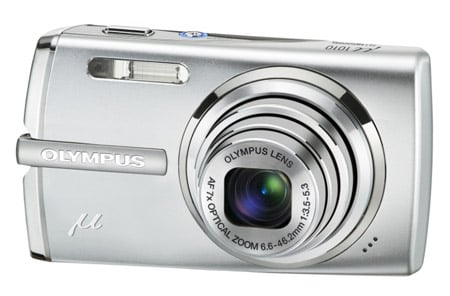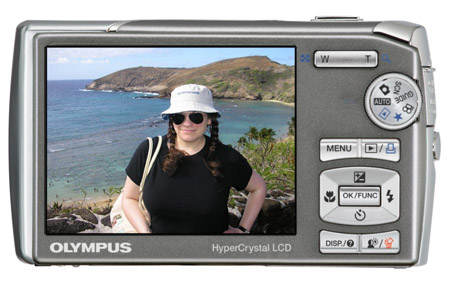Original URL: https://www.theregister.com/2008/04/09/review_olympus_mju1010_compact_camera/
Olympus µ1010 compact camera
Silly name aside, this is a quality camera
Posted in Personal Tech, 9th April 2008 14:08 GMT
Review The curiously named Olympus µ1010 is also known as the mju 1010, which doesn’t make it any easier to pronounce. It comes in three groovy - or garish - colours, silver, black and metallic blue.
This is a pretty well-specified camera considering the price and target audience. There’s a beefy 7x 6.6-46.2mm optical zoom lens for starters, which is equivalent to a 37-260mm zoom on a 35mm camera.

Olympus' µ1010: it even works underwater
The 1/2.33in CCD is a 10.1-megapixel chip, and you also get a twin image stabilisation system, face detection, special technology designed for low-light shooting and 23 scene modes. You can even use the µ1010 underwater, up to a depth of 40m, provided you’ve got an optional underwater case. And a good pair of lungs.
The µ1010 is a slim camera, measuring 99 x 56 x 25mm and weighing 135g without battery. It’s certainly very pocketable. At the front is the usual flash and lens arrangement, while on top is the shutter control and power button - which glows a nice blue colour when switched on. At the side is a flap for a mini USB port, while around the back is 2.7in LCD screen composed of 230,000 pixels. Nearby sits a zoom rocker bar, control dial for various modes, the menu button, a playback button and a four-way arrow pad for controlling macro, flash, timer and exposure compensation.
Below this is a display button and shadow adjust/delete button. Underneath is a spring-loaded cover for the battery and memory card. Incidentally, rather than use an SD card or Memory Stick, the µ1010 uses the xD-Picture card format.
Using the µ1010 is a doddle - even without an instruction book you’d soon get the hang of most features. Switch-on is fast, smooth and simple, and the µ1010 seems to purr as it prepares for action. Set the control dial in auto mode and you can simply point and shoot. In this mode, the µ1010 will more often than not deliver the goods when it comes to picture quality.
Press the menu button and you are presented with a number of on-screen icons that include set-up, camera menu, image quality and panorama. The set-up function is used for adjusting things such as the clock, video out format (PAL or NTSC) and power save mode. Image quality lets you adjust the image size from ten megapixels (3648 x 2736 resolution) down to VGA (640 x 480), with an option for 16:9 (1920 x 1080) shooting, which is useful if your shots are being displayed on a widescreen HD TV or monitor. You can also opt for fine or normal image compression.

Using the µ1010 is a doddle - even without an instruction book
The panorama mode is very smart and offers three options: the camera can automatically take panoramic shots by stitching images together - you simply take a shot, line up two points on the display and the µ1010 does the rest. Or you can take them manually, or create panoramas on a PC, for which Olympus provides the software. That’s the good news.
The bad news: no matter what setting we used, we couldn’t get the panorama function to operate. After much head-scratching we consulted the instruction book, and buried within the text was the news that this function only works with Olympus x-D cards. Ours was a Fujifilm product.
The menu options obviously change depending on your settings. In the semi-automatic mode you can adjust settings such as the white balance, ISO (from 80 to 1600, plus Auto and High ISO Auto), drive (single shot or continuous), AF mode and image stabiliser. The Scene mode provides you with a wide choice of shooting options including food, fireworks, portrait, document, sunset and behind glass.
What’s really nice is that as you toggle through the various shooting options, you get a short text description plus an illustrative image. Indeed, press the exposure compensation button and you’re presented with a four-way, split-screen display which shows you the effect of each different setting.
There’s even a shooting guide menu. If you want to shoot into backlight or take a close-up shot, for example, you just scroll to the relevant menu entry, press a button and the µ1010 tells you what setting to use. Press the OK button and the camera will even set up the function for you. If you’re a techno-savvy person it’s easy to dismiss these features as gimmicks, but many people will find them useful. Finally, there are two movie modes: VGA at 30f/s and 320 x 240 at 15f/s.
We liked using this camera. It offers simple, no-fuss shooting and can deliver excellent picture quality under a variety of conditions. The 7x zoom was a joy to use and really pulled in the action. This was far more useful than having a couple of extra million pixels on the CCD. The image stabilisation system does a good job in keeping things steady when you’re shooting at the longest focal length.
Sample shots
Click for full-size image

You won’t be disappointed with the results from this camera and its ten-megapixel images are fine for making A3-sized prints

Taking shots in low light wasn’t a problem, although there is the inevitable noise as seen on the singer’s top
Sample shots

The µ1010 has a super macro function that lets you take shots just a few centimetres away from an object

The 7x zoom really takes you close up to distant subjects. In this shot, look at the blue sign with the white text in the far right-hand corner
Low-light shooting was impressive too, although there is the inevitable increase in picture noise as the ISO shifts up a notch or two. Even so, the shots we took around a city at dusk and inside a dark club were pretty presentable. And if you’re not completely satisfied with the results, there’s even a bunch of in-camera editing features that include cropping, shadow adjustment, red-eye correction and colour editing.
The swift start-up is accompanied by an auto-focus system that soon locks onto the target. Battery life was good too - we shot well over 200 images on a single charge.
Verdict
The only fly in the Olympus µ1010 ointment is that it takes the several seconds before it’s ready for the next shot, unless you use the continuous mode function - although you have to settle for smaller image files if you use this feature. The µ1010 isn’t aimed at the enthusiast, but then it’s much more than just a basic camera. Best of all, it’s packed full of friendly features.
